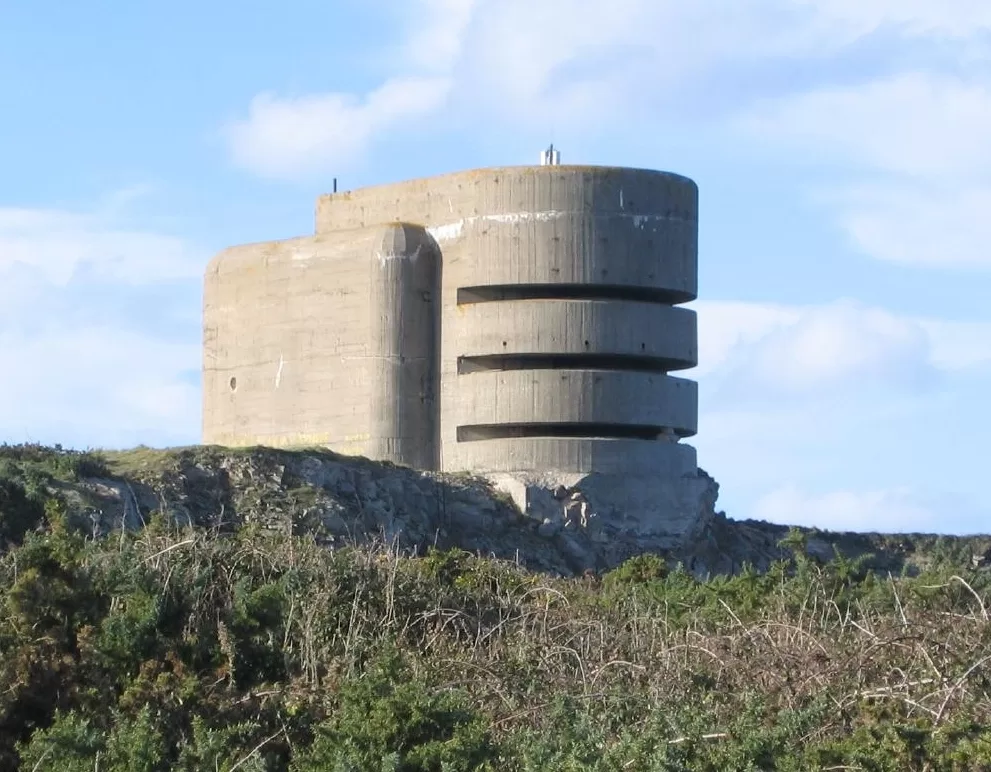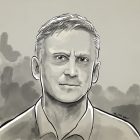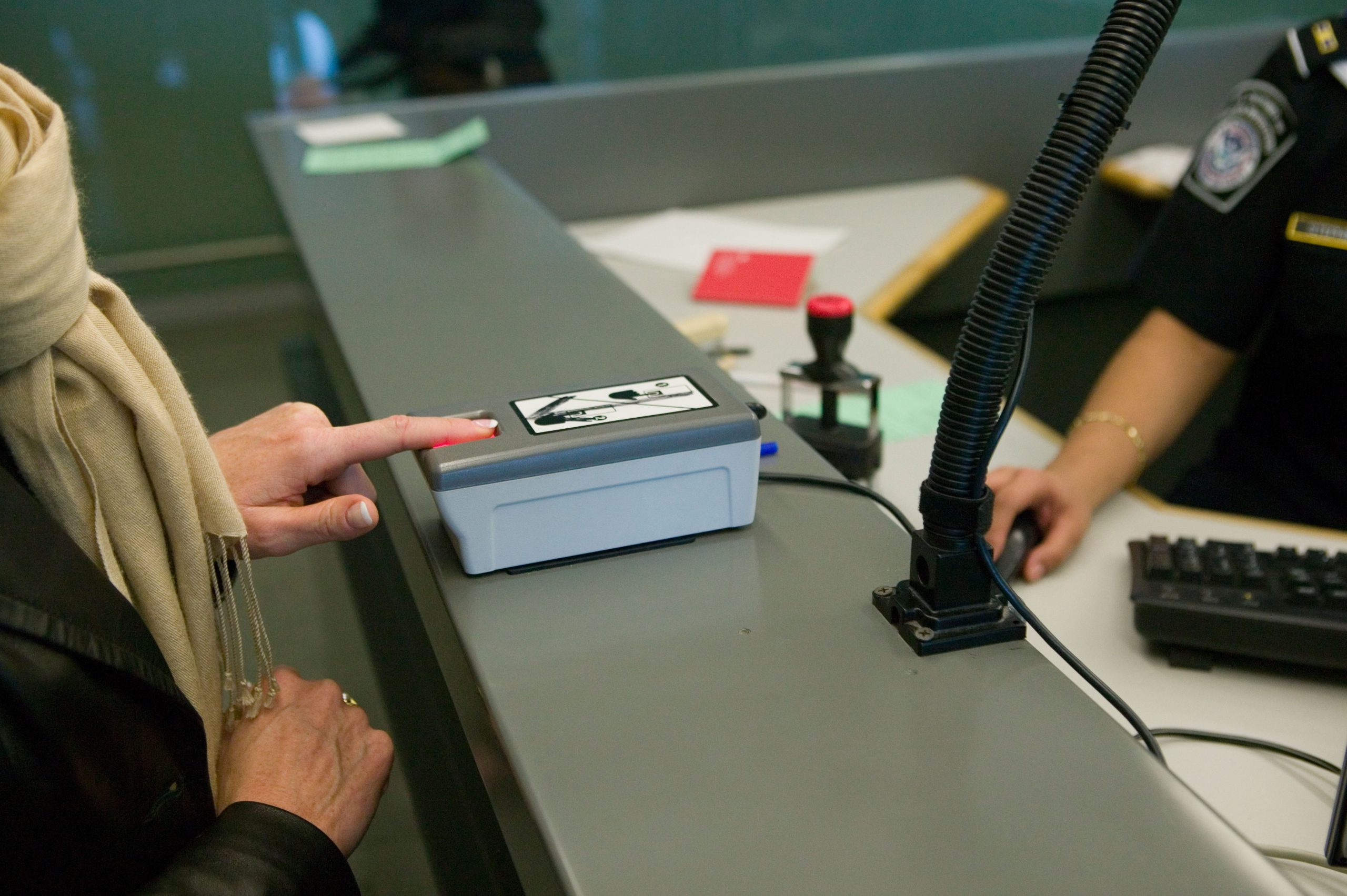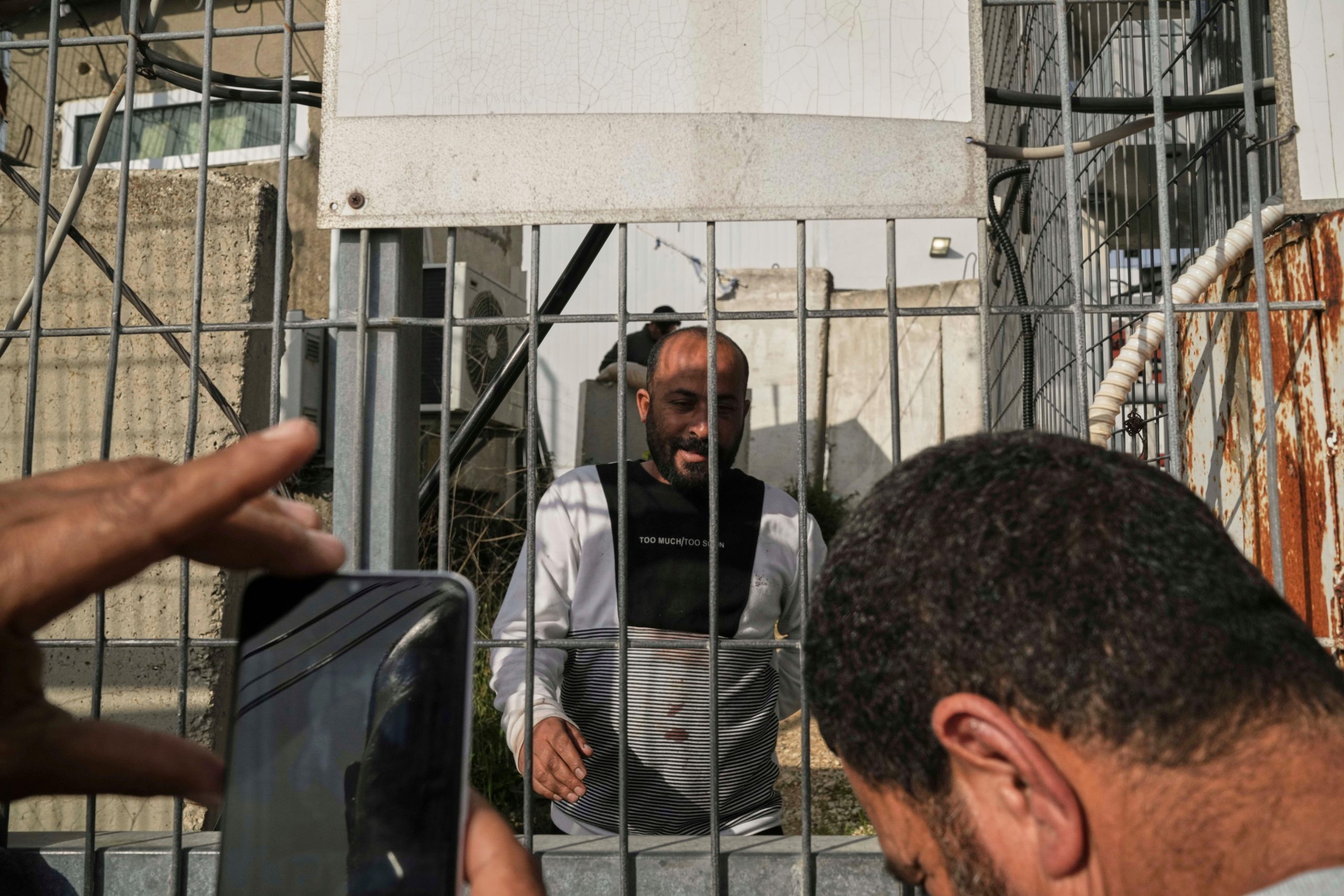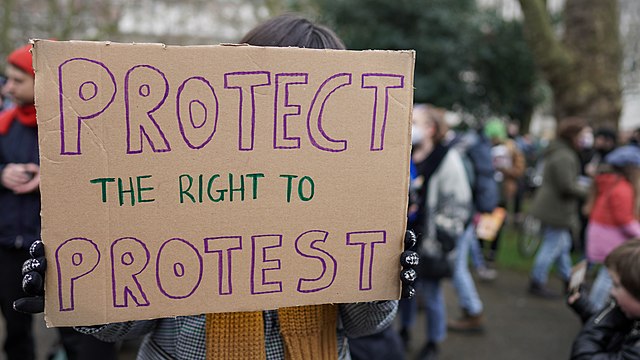In a West London art gallery, a pock-marked relief sculpture provides a devastating visual representation of a wartime Nazi atrocity. The piece is both a work of art and evidence from a crime scene: a cast of a wall riddled with bullet holes. The cast could have been taken from any number of sites across Nazi-occupied Europe. But this wall is on Alderney – one of the Channel Islands and part of the British Isles – which surrendered to the German army in 1940.
The artist Piers Secunda, who created the work, has been told by forensics experts that it was used by a German firing squad. Secunda is part of a growing group of campaigners, journalists, researchers and politicians who believe the full story of the occupation of Alderney has never been told. In particular, he believes the fate of Jewish prisoners on the island has been conveniently minimised to protect the idea of British exceptionalism. If he is right, we will have to reassess our understanding of the history of the geographical boundaries of Hitler’s Final Solution. Hence the exhibition’s title: The Holocaust on British Soil.
Just eight Jews are officially recorded as dying on Alderney. Secunda, who describes himself as a researcher as well as an artist, is sceptical. Another of his works includes reproductions of lists of deportees compiled by the French Nazi-hunter Serge Klarsfeld. Secunda is now writing to the families of 400 French Jews who are known to havebeen transported to the island from the notorious transit camp at Drancy in the suburbs of Paris.
“If many hundreds of Jews were sent to Alderney and we know the death rate of prisoners was high-between 30% and 40% – how is it possible that only eight people died on the island? There is a disconnect, and my interest is to join the dots,” he told Index.
An inconvenient truth
While Alderney is technically a Crown Dependency and not a part of the United Kingdom, the British government was responsible for the surrender of the Channel Islands. The occupation of these islands has always been an inconvenient truth. By the summer of 1940, Prime Minister Winston Churchill’s War Cabinet concluded the islands could not be defended, and at the beginning of July, Jersey, Guernsey, Sark and Alderney were all occupied.
However, unlike on the other islands, all but a handful of people on Alderney were evacuated. This paved the way for the island to be turned into a vast prison for slave workers constructing Hitler’s sea defences. In January 1942, therefore, four camps – Helgoland, Norderney, Sylt and Borkum – were set up for workers from so-called Operation Todt. Conventional wisdom is that the majority of those transported to the island were Russian prisoners of war. But the records show a significant proportion of those in the camps were Spanish Republicans, north African Arabs and French Jews.
The conditions on Alderney were appalling and, in common with other Nazi work camps, prisoners were beaten and starved. Many succumbed to disease. Those who could no longer work were sent to camps in mainland Europe where they were murdered. The overall numbers of those who died on the island is also the subject of academic controversy: the minimum estimate is between 700 and 1,000 people, but experts believe the actual figure could be much higher.
Immediately after the liberation of Alderney, two senior British soldiers, Major Cotton and Major Haddock, were sent to investigate war crimes. As a result, the Judge Advocate General’s (JAG) office, the body responsible for bringing Nazis to justice, concluded the conditions were akin to those in other concentration camps in German-occupied territory: “The position here is somewhat similar to Belsen, stronger perhaps because the offences were committed on British territory.” A young captain, Theodore Pantcheff, was brought in to carry out a full investigation. In September 1945 he wrote: “Wicked and merciless crimes were carried out on British soil in the last three years.”
And yet Britain did not bring a single German officer to justice for what happened on Alderney. Instead, the authorities chose to focus on the Russian victims of the regime in the island’s camps and shift the responsibility for any investigation to the Soviet authorities. In October 1945, Pantcheff’s report was sent to Moscow, where it lay in the archives until 1993. The British copy was destroyed.
When the report finally came to light, it revealed that 15 suspected war criminals had been in British custody at the end of the war. In his memoirs, Pantcheff claimed that three of the most notorious of these, Maximilian List, Kurt Klebeck and Carl Hoffman, had not survived the war. This was untrue. Hauptsturmführer List was in charge of Sylt, the only SS camp on British territory. After the war, he
was traced to a British prisoner-of-war camp and was said to have been handed over to the Russians. In fact, he was living in Germany well into the 1970s. Obersturmführer Klebeck, List’s deputy, lived out his days in Hamburg, despite being convicted of other war crimes in 1947 and being the subject of German investigations in the 1960s and the 1990s.
Most shocking is the story of Major Hoffman, the Kommandant of Alderney and its four camps, who Pantcheff said had been handed over to the Russians and executed in Kyiv in 1945. The British government was forced to admit the truth in 1983: that Hoffman was taken from Alderney and held in the London Cage – for prisoners of war – until 1948, when he was released and allowed to return to Germany. He died peacefully in his bed in Hamelin, West Germany, in March 1974.
The story of Alderney is one of silence, state censorship and missed opportunities. Hoffman and the other war criminals should have faced justice immediately after the end of hostilities. The British government has never explained why it allowed them to go free nor why it pursued a policy of “Russification” of the atrocities committed on the island. But there is no doubt this was a conscious policy. The details are contained in Madeleine Bunting’s 1995 book, The Model Occupation. In it she said that Brigadier Shapcott from JAG wrote in 1945 that all the inmates on Alderney were Russian, and Britain’s Foreign Office concluded that “for practical purposes Russians may be considered to be the only occupants of these camps”. JAG also told the Foreign Office: “No atrocities were committed against the French Jews. On balance they were treated better than the others working for the Germans.”
There have been a number of attempts to correct the historical record by drawing attention to the camps on Alderney and the presence of Jewish prisoners. Most notable is the work of Jewish South African archaeologist Solomon H Steckoll, whose book The Alderney Death Camp was published in 1982 and serialised in The Observer newspaper. His direct, impassioned approach is captured in the cover blurb: “In 1943 the SS built a concentration camp on the British island of Alderney. Prisoners were worked as slaves, beaten, starved, hanged, garrotted, hurled from cliff-tops, even buried alive in setting concrete. Why have these horrific acts been kept from the public for so long?”
The Alderney Death Camp is a remarkable piece of investigative journalism driven by the author’s own burning sense of injustice. Many on Alderney dismissed it as a tabloid hatchet job. But it is nothing of the kind, not least because Steckoll made it his personal mission to find Hoffman and reveal the full scale of the British government’s cover-up. This will be his legacy.
Steckoll’s revelations prompted a grudging recognition from the British government that it had not told the truth about Hoffman. It did not, though, lead to full disclosure. Those files on the Channel Islands that had not been destroyed remained closed for at least another decade, when Labour MP David Winnick, who is Jewish, began campaigning for their release.
From May 1992, Winnick also pushed for an investigation into the war crimes on Alderney committed by Klebeck, who was by then known to be at large in Hamburg. By the end of the year, he had succeeded on both fronts (although no files released made any reference to Alderney). Winnick’s campaign was followed two years later by the publication of Bunting’s book. Nearly 30 years on it still bears scrutiny as a major piece of journalism; Bunting’s tone as she grapples with the British government’s decision-making is a mixture of shock and justified anger.
Her conclusion is stark: “Trials on British soil would have been an acutely embarrassing reminder to the British public of several painful facts about the war which the government wanted quickly forgotten: that British territory had been occupied for five years; that British subjects had collaborated and worked for the Germans on Alderney; and that Nazi atrocities, including the establishment of an SS concentration camp, had occurred on British soil.”
Silence on the island
One block on transparency has been the attitudes on Alderney itself. Academics and journalists have faced hostility on the island. Caroline Sturdy Colls, professor of conflict archaeology at Staffordshire University, was the first to apply modern forensic techniques to sites on Alderney. Her book, Adolf Island: The Nazi Occupation of Alderney, was published last year. Nearly 80 years after the end of the war, the subject of what really happened on Alderney remains highly sensitive among some residents who don’t want their island paradise to become part of what they see as the Holocaust industry.
“There are certainly some islanders who want to help memorialise the victims and tell their stories, so not everyone wants to forget,” Sturdy Colls told Index. “Those that do often provide reasons like not wanting the island to be tarnished by this dark history or not wanting tourism based on Nazi sites.”
The archaeologist said there were a host of other reasons why the subject of the camps on Alderney has proved controversial. “There are many people who still don’t recognise the crimes that were perpetrated as being part of the Nazi programme of persecution and/or the Holocaust. After the war, there was a conscious effort by the government to play down the atrocities that were carried out, and so a sanitised narrative emerged that a good proportion of the British public believed or chose to believe. Some of the islanders who went back to Alderney found it too painful to discuss what had happened there, whilst some residents after the war didn’t (and still don’t) want the island to be known for the occupation-era sites that exist there.”
There have been several key moments when a full and accurate narrative should have been told. Immediately after the war, the Pantcheff report could have led to a war crimes trial, but the British government chose to draw a veil over the atrocities.
The extraordinary work of Steckoll in 1982 could have prompted an inquiry, but instead it was dismissed as sensationalist. The combined efforts of Winnick in parliament and Bunting in the press could have opened the door in the mid-1990s, but again the government chose obfuscation rather than openness.
We have another such opportunity now. The mantle of Steckoll has been taken up by another Jewish investigator, Marcus Roberts, who is determined to pursue the truth about the Holocaust on British soil. He believes it is possible that between 15,000 and 30,000 people died on the island, with at least 1,000 being Jewish.
Roberts is the founder of the Jewish heritage charity JTrails. He began researching the Nazi camps of northern France in 2007. Two years later he turned his attention to the Channel Islands. He has been pushing for official recognition of Alderney as a Holocaust site, the establishment of an appropriate memorial and protection of Jewish graves. Roberts has established it was not just French Jews who were sent to Alderney; there were Jews from many from other parts of Europe and north Africa.
His research demonstrates that a considerable number of Jews are likely to have died on the island from dysentery and disease. His view is that the push for a Soviet inquiry was a smokescreen. Roberts told The Observer: “The way I read it is that the investigation regarding the Russians was undertaken first as a diversion from war crimes against other nationalities, but also there was definitely discussion in the papers we can read that they wanted to guarantee access to Allied war graves on Russian territory. It was also about plausible deniability.”
Although she has challenged the numbers cited by Roberts, Sturdy Colls also believes the scale of the Jewish atrocities has been downplayed. “It is evident from the wide range of testimonies available and from the surveys we did of the camps in which Jews were housed that they were treated appallingly, and more Jews likely died than we know of,” she said. “The conditions in which Jews were housed were an extension of those that they were kept in elsewhere in Europe. The camps on Alderney were part of a network of sites that housed Jews and harsh punishments, terrible working and living conditions, and torture characterised their lives on Alderney.”
She added that it was important to recognise the atrocities committed against other groups on Alderney – eastern Europeans and Jehovah’s Witnesses, for example. “Overall, the suffering of most of the people who were sent to Alderney and were under the control of Organisation Todt and the SS has been underplayed.”
The momentum towards full disclosure may now be irresistible. In recent years, investigative journalists
around the world have turned their attention to Alderney, and the story has been covered by The Sunday Times and ITV in the UK, Channel 9 in Australia, Der Spiegel in Germany and The Times of India. One of the most comprehensive investigations was carried out last year by Isobel Cockerell for the international online publication Coda Story.
Her article on Alderney has been nominated for the 2023 Orwell Prize for Journalism. In it she asks the key questions: “Why did the British government let evidence of German war crimes on its soil … remain in obscurity? Why was no one prosecuted?” She says the islanders have a range of answers: collective shame at surrendering the islands and subsequent collaboration; the post-war focus on rebuilding the country; a view that the scale of the atrocities didn’t merit war crimes trials; and also that “no government wanted talk of Jewish murders on its soil”.
A record to correct
Events in the next few years may force the government’s hand and prompt ministers to correct the historical record. In 2024, the UK will take its turn as chair of the International Holocaust Remembrance Association. The body is responsible for Holocaust education,remembrance and research around the
world. Lord Pickles is the UK’s special envoy for Post-Holocaust Issues and the head of the UK’s IHRA delegation. On visits to Alderney, Pickles has told islanders they need to come to terms with the troubled history of the camps and find a way of marking what happened with a respectful memorial.
Later this year, Pickles will announce an expert review of the numbers who died on Alderney and invite submissions from academics, researchers and members of the public. The IHRA is seeking to adopt a charter to safeguard all sites of the Holocaust in Europe. Gilly Carr, associate professor in archaeology at Cambridge University and chair of the IHRA Safeguarding Sites project, told Index: “Such sites play
a crucial role in educating current and future generations about the Holocaust and help us reflect on its consequences. In this charter we take a broad approach to what we consider to be a site of the Holocaust. Jews were held in camps in Alderney and we consider these to be Holocaust sites.”
Carr, like Sturdy Colls, believes the full story of Nazi atrocities has been downplayed in the past. “Certainly, the subject of victims of Nazism in the Channel Islands as a whole, a category within which I would include Jews, political prisoners and forced labourers, has come late to the table,” she said. “Because there were no war crimes trials resulting from the occupation of the Channel Islands, it became a ‘non-subject’ for many people.”
Carr has helped develop the concept of “taboo heritage”, where the legacy of war is so sensitive that people become resistant to the idea of full remembrance.
“Taboo heritage can become heritage in the end if it receives political support, but this usually takes a lot of time and investment by stakeholders,” she said.
Pickles is also co-chair of the UK Holocaust Memorial Foundation, the body responsible for planning a
Holocaust Memorial and Learning Centre, which will be built in sight of the Houses of Parliament. British
exceptionalism will be at the heart of the new memorial.
It will celebrate the Kindertransport, the scheme to rescue 10,000 children from Nazi Germany in the nine months before the outbreak of war. It will also celebrate British heroes of the Holocaust, such as Sir Nicholas Winton, who helped rescue 669 children from Czechoslovakia on the eve of war.
There is now a commitment to putting the occupation of the Channel Islands at the heart of the memorial. But what happened here does not sit easily with this narrative of exceptionalism. The horrors of Alderney are a blot on Britain’s reputation, which is perhaps why the full story has been suppressed for so long. The slogan chosen for the memorial is “Confronting Evil, Assuming Responsibility”. Will we now confront the evil of the camps on Alderney and assume responsibility for covering up what happened there?

